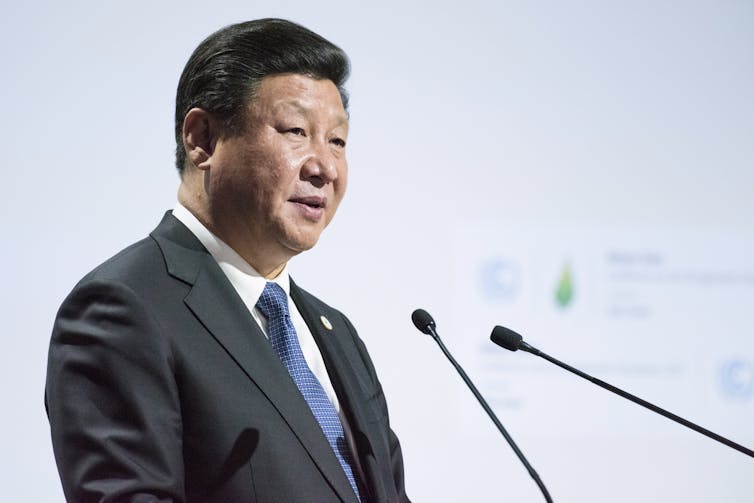Source: The Conversation – UK – By Julian Hargreaves, Senior Lecturer, Department of Sociology and Criminology, City St George’s, University of London
A man believed to be Jihad Al-Shamie, a 35-year-old British citizen born in Syria, has been shot dead by police after launching an attack on a synagogue in Manchester on Yom Kippur, the holiest day in the Jewish calendar. Melvin Cravitz, 66, and Adrian Daulby, 55, died in the attack – one having been accidentally shot by police trying to stop the suspect.
According to BBC News, a member of the public called the police at 9:31am to report the incident. Greater Manchester Police deployed firearms officers to the scene at 9:34am. At 9:38am officers declared “Operation Plato” – a code word used by UK emergency services for a marauding terrorist attacker. At 9:39am, armed counter terrorism police officers, shot and killed Al-Shamie who died at the scene. Counter terrorism police later confirmed the attacked as a “terrorist incident”.
Within hours, it had become clear that many foresaw such an attack. The Financial Times reported comments from Marc Levy, chief executive of the Jewish Representative Council, a body representing Jewish communities in Greater Manchester. Levy described the events as “an inevitability”.
The Board of Deputies of British Jews, a national body representing Jewish communities across the UK, described the attack as “sadly something we feared was coming”.
The Jewish Chronicle, a Jewish interest newspaper, reported that staff at the London Centre for the Study of Contemporary Antisemitism were “shocked but not surprised”.
Recent research by the thinktank Antisemitism Policy Trust analysed demonstrations against the war in Gaza. It found public expressions of anti-Jewish hatred alongside more legitimate pro-Palestinian and anti-Israeli government sentiment, including Arabic chants referencing the massacre of Jews in 628BC.
The Community Security Trust, an organisation serving and protecting Jewish communities, records and reports antisemitic incidents in the UK. In 2023, the CST recorded 4,296 incidents – the largest number in a single year. CST used previous lower annual totals to explain how antisemitism is now fuelled by responses to the October 7 Hamas attacks: 1,684 incidents in 2020, 2,261 in 2021 and 1,662 in 2022.
The CST works carefully to investigate and verify all reports of antisemitism. While their work is entirely robust, it cannot easily reveal whether the dramatic rise in incidents reflects growing antisemitic sentiment, or increases in the reporting of antisemitic incidents to the CST, or both.
According to Home Office figures, religious hate crime against Jewish people more than doubled between the years ending March 2023 to March 2024. In 2022-23, there were 1,543 incidents recorded by the police. In 2023-24, there were 3,282.
While the number of incidents is lower than those against Muslim people – 3,432 in 2022-23 and 3,866 in 2023-24 – Jewish people are more likely to suffer religious hate crime. There were 121 incidents for every 10,000 Jewish in England and Wales compared to 10 incidents for every 10,000 Muslim people.
The same caveats apply here. We cannot know whether these increases represent growing hostility towards Jewish people in the UK or more Jewish people reporting hostility to the police. This issue is further complicated by the fact that police-recorded crime is no longer regarded as meeting the standard required of reliable national statistics due to poorly managed recording practices.
How widespread is antisemitism in the UK?
In 2017, the Institute for Jewish Policy Research (JPR) published what is arguably the most robust mapping of antisemitism in the UK. It estimated the extent of anti-Jewish attitudes using a nationally representative survey.
The JPR found that around 2% of the UK population might be labelled as “hardcore” antisemites and a further 3% as “softer” antisemites on the basis that both groups hold multiple antisemitic ideas. It also found that at least one more antisemitic idea is held by 30% of British society.
It is difficult to say with clarity whether or not antisemitism is rising in the UK, mainly because police statistics are so unreliable. But when terrorist attacks occur, we seek to understand what has happened and reach for robust information. This creates an urgent need for fresh research with better police data and more recent crime data.
Regardless of all this, findings from the JPR show that while strong antisemitism remains relatively uncommon in the UK, the odds of Jewish people encountering neighbours with at least one antisemitic idea remains worryingly high. Small wonder then that so many felt this attack was just a matter of time.
![]()
Julian Hargreaves does not work for, consult, own shares in or receive funding from any company or organisation that would benefit from this article, and has disclosed no relevant affiliations beyond their academic appointment.
– ref. Manchester synagogue attack: why so many people in Britain’s Jewish community felt a sense of inevitability that this day would come – https://theconversation.com/manchester-synagogue-attack-why-so-many-people-in-britains-jewish-community-felt-a-sense-of-inevitability-that-this-day-would-come-266638













